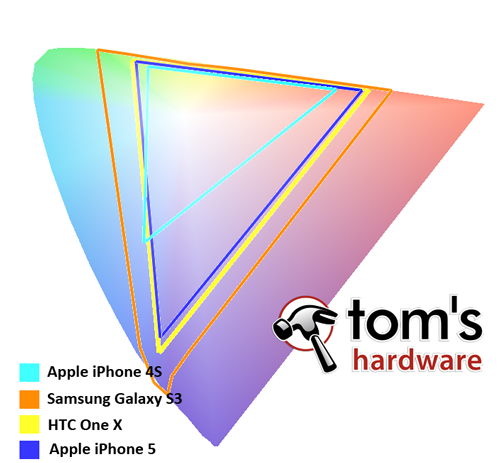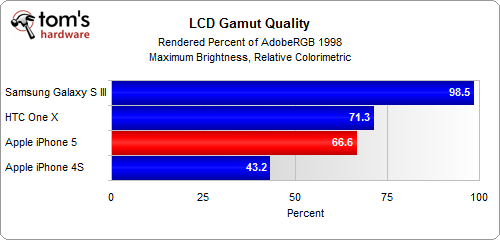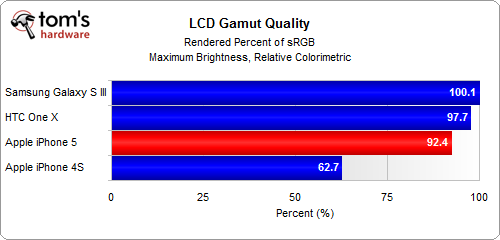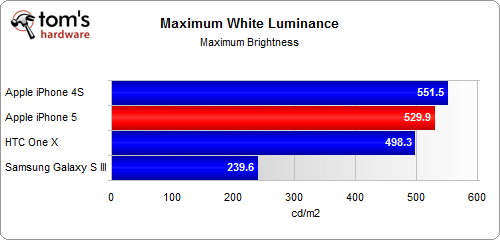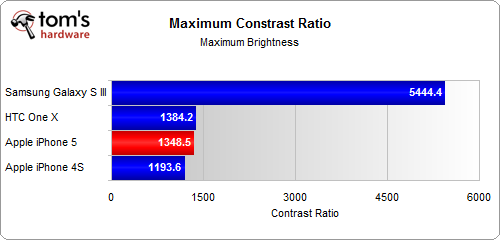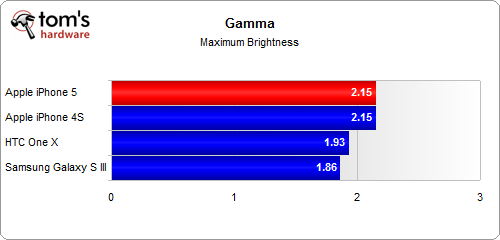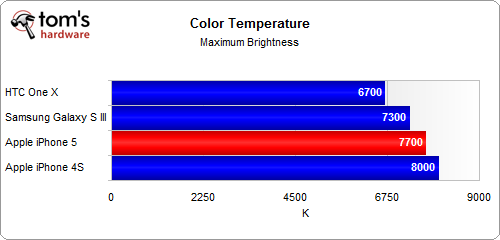Apple iPhone 5 Review: CPU, GPU, Battery, Wi-Fi, And Display Testing
LCD Performance, Quantified
If you plot out the iPhone 5's gamut over an LUV (Luminescence, red-to-green, blue-to-yellow) color map, it's pretty clear that we're dealing with a different LCD screen than what the iPhone 4S used. Apple cites similar technical specs, but the color output is inherently different. Even if the pictures on the previous page seem like they could be subjective, the gamut map proves that there’s a substantial increase in blue saturation.
According to Apple, color saturation on the iPhone 5 is 44% higher than what you get on the 4/4S. That claim is based on the NTSC 1953 standard, named for the year when it was codified. It's mainly used in discussions about televisions.
Computer monitors evolved at a much faster pace than televisions, though. And as a result, we often talk in terms of much bigger gamuts. Adobe RGB1988 and sRGB are more commonly the references when it comes to photography, printing, and color accuracy.
We measure a gamut value of 66% for the iPhone 5 in Adobe RGB1998. That's a roughly 54% increase over the iPhone 4S, which we peg at 43%. That’s a substantial gain, backed by the sRGB measurement that shows the iPhone 5 achieving 92% of the sRGB color space.
However, the One X puts up slightly better results. Covering 97% of the sRGB gamut, HTC’s flagship looks remarkable compared to the iPhone 5. Although that 5% delta may not seem like much, it is apparent if you have an eye for photography.
But the crown goes to Samsung's Galaxy S III. It’s the only example of the four phones we're testing with an AMOLED screen, and that's why it has an insanely high contrast ratio of 5444:1. Blacks truly look black. Even though its luminance result isn't that high, Samsung's S III looks just as brilliant as the iPhone 5, and it boasts better color fidelity.
Get Tom's Hardware's best news and in-depth reviews, straight to your inbox.
Current page: LCD Performance, Quantified
Prev Page A Retina Display With 44%-Greater Color Saturation? Whoa. Next Page Camera Quality: Better In Low Light; Purple Flare "Normal"-
g-unit1111 Why can't everyone - Apple included - agree on a standardized power adapter like mini USB?? It would make not only our lives easier but the manufacturers who make these accessories able to have one device and on cord that works with everything.Reply -
mayankleoboy1 The LCD tests puzzle me a little. Most other reviews said that the SGS3 has a poorer display and the iphone5 has a better display , with much better contrast ratio and sRGB compliance.Reply
Maybe i am reading it wrong ? -
reprotected There needs to be more explanation in the quality of the screens. We all know Galaxy SIII covers a larger colour gamut, but does it beat the iPhone 5 in terms of accuracy is one big thing we want to know based on your eyes, not numbers and graphs.Reply -
kensingtron Great article ^_^Reply
Second to last paragraph:
"For example, Samsung's Galaxy S III has been on the market for a while, and its LCD is a market leader"
LCD = AMOLED -
acku kensingtronGreat article ^_^Second to last paragraph:"For example, Samsung's Galaxy S III has been on the market for a while, and its LCD is a market leader"LCD = AMOLEDReply
My apologies. On page 6 we mentioned that S3 uses AMOLED. I'll make a correction. Thanks for the shout out. -
dragonsqrrl Excellent article as usual, very comprehensive. Hopefully this helps to dispel some of the performance myths about the iPhone that seem to circulate here on Tom's.Reply -
acku mayankleoboy1The LCD tests puzzle me a little. Most other reviews said that the SGS3 has a poorer display and the iphone5 has a better display , with much better contrast ratio and sRGB compliance.Maybe i am reading it wrong ?Reply
http://news.cnet.com/8301-13579_3-57524291-37/color-me-prettier-galaxy-s3-display-outdoes-iphone-5s/ Check that one out. :)
I'd still like to add an accuracy test at some point. I need to think about how to approach that problem. The way people normally talk about color accuracy (besides deltae and gamma) are sometimes too abstract with color terms that professionals use. I'd like to find a way to present the information in a more intuitive manner. -
ojas g-unit1111Why can't everyone - Apple included - agree on a standardized power adapter like mini USB?? It would make not only our lives easier but the manufacturers who make these accessories able to have one device and on cord that works with everything.Agreed...though don't most smartphones today use the microUSB B-type connector?Reply -
dare2blink Seems apple has not inovated for a couple of years now. I´m shocked that the most inovative and arguably the best phone of the year is not even mentioned in this article. Nokia Lumia 920 is definitely the most inovative na the most complete phone reseased so far. It has much better build quality, a better screen and camera than the iphone 5, not to mention a much more inovative OS.Reply
